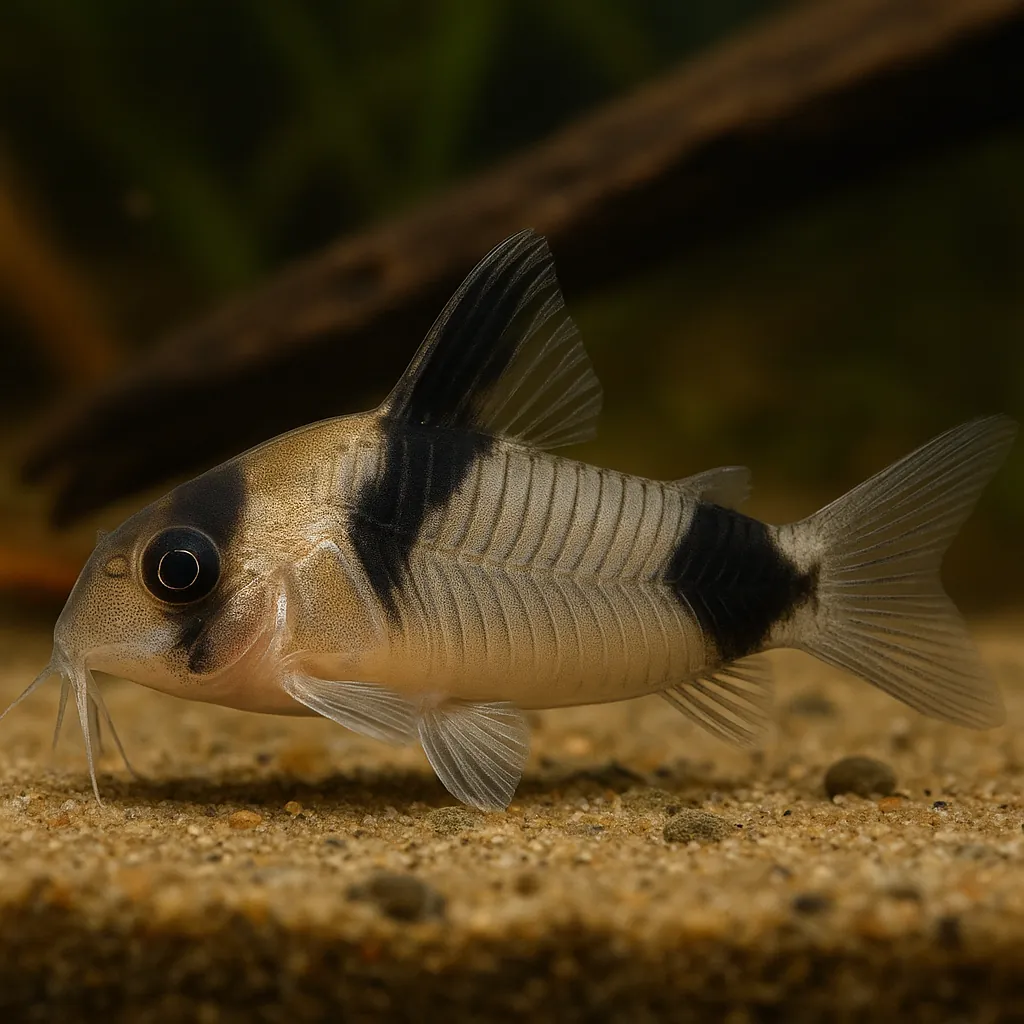
False bandit cory
Introduction
The False Bandit Cory (Corydoras melini) is a captivating freshwater fish cherished by aquarists for its striking appearance and peaceful demeanor. Characterized by a distinctive black band running from its dorsal fin to the base of its tail, this species adds visual interest to any aquarium. Its manageable care requirements make it an excellent choice for both novice and intermediate fishkeepers.
What makes the False Bandit Cory a popular choice among aquarists?
Its unique markings, gentle nature, and compatibility with various tank mates contribute to its popularity in the aquarium hobby.
Is the False Bandit Cory suitable for beginners?
Yes, due to its hardy nature and straightforward care needs, it's well-suited for those new to fishkeeping.
Care and Environment
Providing optimal care for the False Bandit Cory involves attention to tank setup, water conditions, and dietary needs.
What is the minimum tank size for a single False Bandit Cory?
A minimum of 60 liters is recommended to accommodate a small group, as they thrive in social settings.
What are the ideal water parameters for this species?
Maintain a temperature between 22–26°C, pH levels from 5.5 to 7.0, and water hardness of 1–15 dGH to replicate their natural habitat.
Use a fine sand substrate to protect their delicate barbels, and include hiding spots like driftwood and plants to mimic their native environment. Ensure gentle filtration and moderate lighting to keep them comfortable.
As omnivores, False Bandit Corys accept a variety of foods. Provide high-quality sinking pellets or tablets as a staple, supplemented with live or frozen foods like bloodworms and brine shrimp to ensure a balanced diet.
Regular water changes and monitoring of ammonia, nitrite, and nitrate levels are crucial, as they are sensitive to poor water quality.
How often should I feed my False Bandit Cory?
Feed them small portions once or twice daily, ensuring all food reaches the bottom where they can access it.
Origin and Habitat
Native to South America, the False Bandit Cory inhabits the upper Rio Negro and Meta River basins in Brazil and Colombia. These regions are characterized by blackwater rivers and creeks with slightly acidic, soft water. The fish are often found in areas with dense vegetation and submerged roots, providing ample hiding spots and foraging grounds.
What type of environment does the False Bandit Cory prefer in the wild?
They thrive in slow-moving, tannin-rich waters with abundant plant life and soft substrates.
How can I replicate their natural habitat in my aquarium?
Use a soft sand substrate, include driftwood and live plants, and maintain slightly acidic water conditions to mimic their native environment.
Temperament and Compatibility
False Bandit Corys are peaceful, social fish that thrive in groups of at least six. They exhibit shoaling behavior, which provides them with a sense of security and encourages natural behaviors.
What are suitable tank mates for the False Bandit Cory?
Compatible companions include small, peaceful species like tetras, rasboras, and dwarf cichlids that share similar water parameter requirements.
Are there any fish species to avoid housing with False Bandit Corys?
Avoid aggressive or fin-nipping species, such as larger cichlids or barbs, which may harass or harm them.
Providing a harmonious community tank with appropriate tank mates will ensure the well-being and longevity of your False Bandit Corys.
Interesting Facts
The False Bandit Cory is often confused with the Bandit Cory (Corydoras metae), but can be distinguished by the black stripe extending into its tail. In the wild, they have adapted to low-oxygen environments by occasionally gulping air at the water's surface, absorbing oxygen through their intestines—a behavior that can also be observed in aquariums.
How can I differentiate between male and female False Bandit Corys?
Females are typically larger and rounder, especially when carrying eggs, while males are more slender with pointed ventral fins.
Is breeding False Bandit Corys in captivity challenging?
Breeding can be achieved by simulating seasonal changes, such as lowering the water temperature and pH, to trigger spawning behaviors.
Sources
All information in this article has been gathered from the following reputable sources:
Overview
Recommended Tank Size 21.1 Gallons (for groups of 6 or more) |
Minimum Group Size 6 |
Minimum Tank Volume 15.9 Gallons |
Maximum Adult Length 2 inches |
Average Adult Length 1.6 inches |
Shoaling (6+ required) Yes |
Preferred Water Type Freshwater, soft, slightly acidic |
Temperature Range (°C) 22–26 |
pH Range 5.5–7.0 |
Water Hardness (dGH) 1–15 |
Typical Lifespan (years) 5 years |